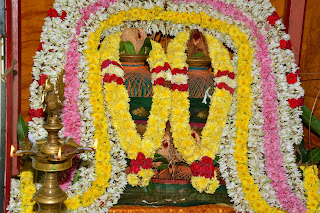
Homam (also known as Havan in Hindi) is a religious ritual performed by Hindus in general and Brahmins in particular, to invoke the blessings of specific Gods and Goddesses. It begins with the performer known as Karta (devotee) invoking Agni (God of fire) and inviting him to carry the offerings into the fire, to the concerned deity. The Gods, pleased with the offerings grant the wishes of the devotees in the form of benefits like longevity, good health, wealth, success in business, ward off evils, get rid of enemity, gain prosperity, progeny etc., etl.
In fact, the invoking of Fire God is (i.e. Agni) is traditionally considered as the carrier of our prayers and offerings to the concerned deity/devatha. It is said that since these devathas are so powerful, they are not easily reachable to the ordinary man. The Agni acts as an easy and approachable intermediary who can pass on our devotion and prayer to the devathas. The Agni along with his two brothers, takes our offerings to the Gods, through the powerful Vedic recitals of specific Mantra,given for each ritual.
The Ayush Homam is one such, performed on the completion of first year of birth Nakshatra (note - not as per birth date, but the day of constellation that falls on the same Indian Calender month in the following year of birth). Primarily to pray for longevity and prosperity of life this Homam is performed.
Ayush = meaning age or tenure of life, and Homam, the invocation of the deity through a consecrated fire. Though it is usually performed on the First birthday (Star-wise) of the baby. it can even be performed anytime later during one’s lifetime.
After the purification of the place where the Ayush Homam is held, i.e. Graha Suddhi Punyahavachanam, the priests are invited to invoke the Lord Brahma, through their prayers. The recitals are at least with three such priests, chanting the Ayush Sooktham in unison. Then, the Lords of birth Nakshatra, Family Diety (Kula Devatha) are invoked. Basically, this starts with the Kumbam known as Khalash and then the same is repeated again with the Holy Fire. This can be compared to the respect with which we treat our guests and ensure they feel special. Similarly, the God is also treated in a special way. The perform sits facing east, where the Agni Kundam is kept in front of him in the centre.
The purpose of performing Aayush Homam is that, when a child is born, the possibilities of having the vibrations of previous birth and might identify the previous birth's contacts. To remove that from the present body, they apply certain herbal sticks, that will heat the body and mind, which will remove the poorva jenma karma, and make the child fit to live this generation. In The Holy fire they offer cooked rice, ghee made out of cow's milk and some samithu known as wooden.
sticks of smaller size. While offering these, they recite and chant the Ayush Sooktham for a minimum three times, that contain 8 stanzas.
Ayushya Homam is dedicated to the Life God to enhance longevity - Ayush - i.e. life. Homam is explained by the sage Bodhayana in the Bodhayana sutras. According to Bodhayana, if a child is constantly ill, this Homam could be performed on a monthly basis till the child attains good health. But in general practice, this is performed only at the first year of birth only i.e. day of the star in which the child is born. This Homam is performed on the day the child completes one year of age. In case oneis unable to perform it on this day, it can be done on the consecutive month. It may be done even on a monthly basis. By performing the Ayush Homam the evil effects caused by day of the fortnight (Thithi), day of the week (Vara) & the constellation (nakshatra -star) are eradicated. It bestows longevity, prosperity and good health. It is experienced that even some of the common ailments, which cannot be diagnosed through mainstream medicines, are cured by the performance of this Homam.
After the Homam, the child is given the remainder cooked rice as a Prasadam, added wtih sugar. Then, the child's head is tonsured to get rid of the dirts, that associated while in mother's womb. After giving bath, the ear piercing takes place to complete the function. The general sequences for this ritual is:
1. Changing Holy thread by the performer, (2) Purifying the Home (suddhi punyahavachanam), (3) Anugjam, (4)Sankalpam (5) Vishwakshena Aradhanam (6) Ayurdevatha, Kula Devatha, Ishta Devatha & Nakshatra Devatha aavaahanam in the Kumbam (7) Archanam (8)Recitals of Ayush Sooktham and other Devatha Mantram - Japam (9) Agni Avaahanam (10) Pradhana Ayush Homam - depending on the number of
priests/Bruhaspati, the number can vary from 28 to 108 ahuthis. (11) Nakshatra Devatha, Purusha/Sri Sooktha Homam & (12) Jayathi Homam. And finallythe MahaAseervatham - the blessings of Brahmins with Vedic recitals specific for the function, after offering their due sambavana/Dakshina. Kula Devatha/Perumal/Thayar&AcharyanSambavana. At The end of the function,MangalaAarathi is taken.
The Ayush Homam is also performed during completion of the 60th, 80th & 100th year. Srivaishnavites perform Sri Sooktha, Purusha Sooktha & Sudarsana Homam together with Ayush Homam. Shivites used perform, starting it Ganapathy & Navagraha Pooja, then with Ganapathi Homam & Navagraha Homam. However, for both, after the Ayush Homam & Poorna Ahuthi, a sacrifice known as Jayathi Homam is performed at the end. The Jayathi Homam is, in fact, to be performed at the end of each auspicious Havan known as Homam; this is for all the sect of Brahmins.





